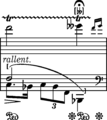



The text of A (→GE→FE→EE) is dubious in this place, particularly considered together with the orchestral part of Morch:
 .
.
The attention is drawn by a clumsy voice leading: the solo piano takes the e 1 of the orchestra with delay and only in the top most voice (moreover, the necessary accidental specifying the top note of the trill is missing over the trill on e
1 of the orchestra with delay and only in the top most voice (moreover, the necessary accidental specifying the top note of the trill is missing over the trill on e 3). ReF allows us to identify this mistake in the 2nd violin part – there should be f
3). ReF allows us to identify this mistake in the 2nd violin part – there should be f 1 instead of e
1 instead of e 1. Against the background of the authentic g
1. Against the background of the authentic g -f
-f 1-b
1-b 1 chord, the source version of the solo part may already be considered to be corresponding to Chopin's intention, and we give it in the main text. The not entirely parallel voice leading present therein – d
1 chord, the source version of the solo part may already be considered to be corresponding to Chopin's intention, and we give it in the main text. The not entirely parallel voice leading present therein – d 1 in the L.H. passes directly into e
1 in the L.H. passes directly into e 1 in bar 261, whereas d
1 in bar 261, whereas d 3 into e
3 into e 3 in the R.H. through e
3 in the R.H. through e 3 – is a phenomenon that can be found in Chopin's works on a number of occasions. For example, the Concerto in E minor, op. 11, 2nd mov., bar 29 and 3rd mov., bars 279-280, the Waltz in G
3 – is a phenomenon that can be found in Chopin's works on a number of occasions. For example, the Concerto in E minor, op. 11, 2nd mov., bar 29 and 3rd mov., bars 279-280, the Waltz in G major, WN 42, bar 56, Fantaisie in F minor, op. 49, bars 104 and 273 and probably the Polonaise in C
major, WN 42, bar 56, Fantaisie in F minor, op. 49, bars 104 and 273 and probably the Polonaise in C minor, op. 26 no. 1, bars 69-70. A similar situation is observed also in bars 243-244 in this movement of the Concerto; however, in this case Chopin eventually smoothened the harmonic sequence. Taking into account the above Chopinesque correction and the fact that the collation of d
minor, op. 26 no. 1, bars 69-70. A similar situation is observed also in bars 243-244 in this movement of the Concerto; however, in this case Chopin eventually smoothened the harmonic sequence. Taking into account the above Chopinesque correction and the fact that the collation of d 1 with e
1 with e 3, multiplied by the trill and not blending into a chordal texture, is more pronounced, we suggest an alternative solution, in which, at the expense of a small modification of rhythm (mitigated by the fermata) and pedalling, one achieves a smoother harmonic sound.
3, multiplied by the trill and not blending into a chordal texture, is more pronounced, we suggest an alternative solution, in which, at the expense of a small modification of rhythm (mitigated by the fermata) and pedalling, one achieves a smoother harmonic sound.
Compare the passage in the sources »
category imprint: Interpretations within context; Editorial revisions
issues: Inaccuracies in A
notation: Pitch


